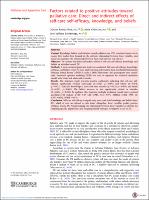Mostrar el registro sencillo del ítem
Factors related to positive attitudes toward palliative care: Direct and indirect effects of self-care self-efficacy, knowledge, and beliefs
| dc.contributor.author | Ramos Vera, Cristian | |
| dc.contributor.author | Krikorian, Alicia | |
| dc.contributor.author | Vallejos Saldarriaga, José Francisco | |
| dc.date.accessioned | 2023-01-18T22:13:13Z | |
| dc.date.available | 2023-01-18T22:13:13Z | |
| dc.date.issued | 2022 | |
| dc.identifier.uri | https://www.cambridge.org/core/journals/palliative-and-supportive-care/article/abs/factors-related-to-positive-attitudes-toward-palliative-care-direct-and-indirect-effects-of-selfcare-selfefficacy-knowledge-and-beliefs/D89AE4A5FB65078D47A43CA8EFDEE267 | |
| dc.identifier.uri | https://hdl.handle.net/20.500.12692/104651 | |
| dc.description.abstract | Context. Knowledge, beliefs, and attitudes toward palliative care (PC) constitute barriers to its access. Few studies have focused on the intrinsic relationship between these variables, and none has examined the relationship between them and self-care self-efficacy. Objective. To examine the direct and indirect effects of self-care self-efficacy, knowledge, and beliefs on attitudes toward PC. Methods. A cross-sectional predictive study was conducted. Self-care self-efficacy, knowledge, attitudes, and beliefs about PC were analyzed using information from the Health Information National Trends Survey (HINTS 5, cycle 2, 2018). Data from 1,162 participants were considered. Structural equation modeling (SEM) was used to represent the statistical mediation model with latent and observable variables. Results. The structural model presents positive coefficients indicating that self-care selfefficacy significantly predicts knowledge (β = 0.127, p < 0.001) and beliefs (β = 0.078, p = 0.023). Similarly, knowledge is associated with attitudes (β = 0.179, p < 0.001) and beliefs (β = 0.213, p < 0.001). The beliefs measure is also significantly related to attitudes (β = 0.474, p < 0.001). In addition, this structural multiple mediation model shows optimal goodness-of-fit indices: χ2/df = 3.49, CFI = 0.983, TLI = 0.976, RMSEA = 0.046 [90% CI: 0.037–0.056], SRMR = 0.038. Conclusion. Self-care self-efficacy is significantly associated with knowledge and beliefs about PC, which in turn are related to each other. Altogether, these variables predict positive attitudes toward PC. Understanding the relationship between these variables is relevant for targeting-specific populations and designing timely strategies to improve access to PC. | es_PE |
| dc.format | application/pdf | es_PE |
| dc.language.iso | eng | es_PE |
| dc.publisher | Cambridge University Press | es_PE |
| dc.relation.ispartofseries | Palliative and supportive care;27 July 2022 | |
| dc.relation.uri | https://www.cambridge.org/core/journals/palliative-and-supportive-care/article/abs/factors-related-to-positive-attitudes-toward-palliative-care-direct-and-indirect-effects-of-selfcare-selfefficacy-knowledge-and-beliefs/D89AE4A5FB65078D47A43CA8EFDEE267 | es_PE |
| dc.rights | info:eu-repo/semantics/openAccess | es_PE |
| dc.rights.uri | https://creativecommons.org/licenses/by/4.0/ | es_PE |
| dc.source | Repositorio Institucional - UCV | es_PE |
| dc.source | Universidad César Vallejo | es_PE |
| dc.subject | Tratamiento paliativo | es_PE |
| dc.subject | Terapéutica | es_PE |
| dc.subject | Atención primaria de la salud | es_PE |
| dc.title | Factors related to positive attitudes toward palliative care: Direct and indirect effects of self-care self-efficacy, knowledge, and beliefs | es_PE |
| dc.type | info:eu-repo/semantics/article | es_PE |
| dc.description.sede | Lima Norte | es_PE |
| dc.identifier.doi | https://doi.org/10.1017/S1478951522000864 | |
| dc.subject.ocde | https://purl.org/pe-repo/ocde/ford#3.01.00 | es_PE |
| dc.publisher.country | PE | es_PE |
| dc.description.lig | Biodiversidad, cambio climático y calidad ambiental | es_PE |
| dc.description.rsu | Promoción de la salud, nutrición y salud alimentaria | es_PE |
| dc.description.ods | Fin de la pobreza | es_PE |
Ficheros en el ítem
Este ítem aparece en la(s) siguiente(s) colección(es)
-
Lima Norte [77]


